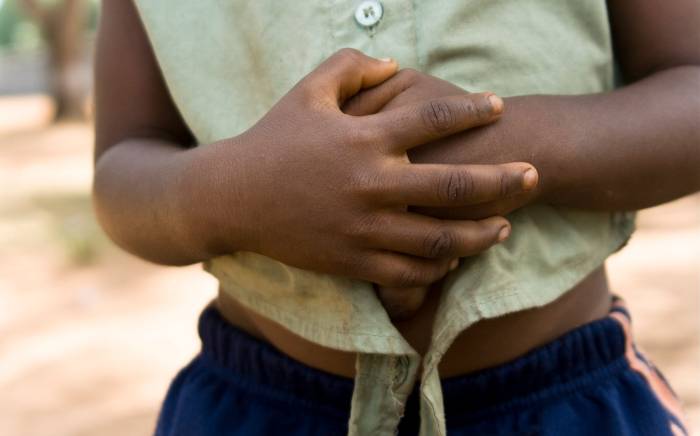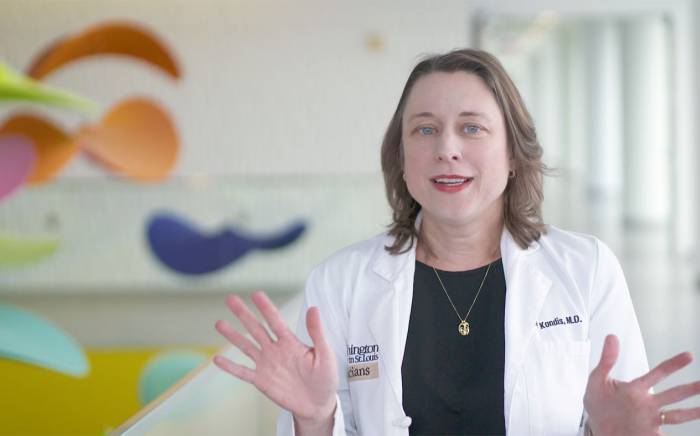Hodgkin's lymphoma, also known as Hodgkin's disease, is a rare cancer in children that affects boys more often than girls. Hodgkin's lymphoma cancer starts in the lymphatic system. The lymphatic system is part of the immune system and it helps to fight diseases and infections. The lymphatic system also helps with balancing fluids in different parts of the body. The lymphatic system includes:
- Lymph. This is a fluid that contains lymphocyte cells.
- Lymph vessels. These are tiny tubes that carry lymph fluid throughout the body.
- Lymphocytes. These are a type of white blood cells that fight infections and disease. Burkitt lymphoma grows from B-cells, one type of lymphocyte.
- Lymph nodes. These are small bean-shaped organs. They are in the underarm, groin, neck, chest, abdomen, and other parts of the body. They filter the lymph fluid as it moves around the body.
- Other organs and body tissues. The lymphatic system includes the bone marrow where blood is made. And it includes the spleen, thymus, tonsils, and digestive tract.
Hodgkin's lymphoma causes abnormal growth of the cells in the lymphatic system. Over time, the body is less able to fight infection and the lymph nodes swell. Hodgkin's lymphoma cells can also spread to other organs and tissues in the body.
(View how Hodgkin's lymphoma affects the body in this educational video.)
For more information about Hodgkin's lymphoma in children or to make an appointment with a pediatric oncologist, please call 314.454.5437 or 800.678.5437 or email us.
Causes of Hodgkin's Lymphoma
The exact cause of Hodgkin's lymphoma in children is not known. Genes and some viral infections may increase a child’s risk of having Hodgkin's lymphoma, but because Hodgkin's lymphoma is so rare in children, the risk is very low.
Some of the conditions that have been linked to Hodgkin's lymphoma are:
- Epstein-Barr virus, which causes mononucleosis (mono)
- HIV, the virus that causes AIDS
- Having a brother or sister with Hodgkin's lymphoma
Symptoms of Hodgkin's Lymphoma
Symptoms of Hodgkin's lymphoma can occur differently in each child and can include:
- Painless swelling of the lymph nodes in the neck, underarm, groin, or chest
- Trouble breathing (dyspnea)
- Coughing
- Chest pain
- Fever
- Night sweats
- Fatigue
- Loss of appetite
- Weight loss
- Itching skin (pruritus)
- Frequent viral infections such as colds, flu, sinus infections
The symptoms of Hodgkin's lymphoma can be similar to those of other health conditions, so make sure your child sees a healthcare provider if they are experiencing any of the above symptoms.
To make an appointment with a healthcare provider at St. Louis Children's Hospital, please call 314.454.5437 or 800.678.5437 or email us.
Diagnosis of Hodgkin's Lymphoma
Your child's healthcare provider will examine your child and ask about your child's medical history and symptoms. Your child may have tests such as:
- Blood and urine tests. Blood and urine are tested in a lab.
- Chest X-ray. The chest X-ray shows the heart, lungs, and other parts of the chest.
- Lymph node biopsy. A sample of tissue is taken from the lymph nodes. It’s checked with a microscope for cancer cells. A lymph node biopsy is needed to diagnose Hodgkin lymphoma.
- CT scan. This may be done for the abdomen, chest, and pelvis. A CT scan uses a series of X-rays and a computer to make detailed pictures of the body.
- MRI scan. An MRI uses large magnets, radio waves, and a computer to make detailed pictures of the body. This test is used to check the brain and spinal cord. Or it may be used if the results of an X-ray or CT scan unclear.
- Positron emission tomography (PET) scan. For this test, a radioactive sugar is injected into the bloodstream. Cancer cells use more sugar than normal cells, so the sugar will collect in cancer cells. A special camera is used to see where the radioactive sugar is in the body. A PET scan can sometimes spot cancer cells in different areas of the body, even when they can’t be seen by other tests. This test is often used in combination with a CT scan and is called a PET/CT scan.
- Bone marrow aspiration or biopsy. Bone marrow is found in the center of some bones. It’s where blood cells are made. A small amount of bone marrow fluid may be taken. This is called aspiration. Or solid bone marrow tissue may be taken. This is called a core biopsy. Bone marrow is usually taken from the hip bone. This test may be done to see if cancer cells have reached the bone marrow.
Part of diagnosing cancer is called staging. Staging is the process of seeing if the cancer has spread, and, if so, where it has spread. Staging also helps to decide the treatment. There are different ways of staging used for Hodgkin's lymphoma. One method of staging Hodgkin's lymphoma is:
- Stage I. The cancer is in a single lymph node region or organ.
- Stage II. The cancer is in 2 or more lymph node regions on the same side of the body. Or the cancer has spread from one lymph node into a nearby organ.
- Stage III. The cancer is in lymph node regions on both sides of the body. It also includes which organs and areas involved.
- Stage IV. The cancer is in the lymphatic system and has spread to other areas of the body (metastasis).
Staging also considers whether a child has certain symptoms and includes:
- Asymptomatic (A). No fever, night sweats, or weight loss.
- Symptomatic (B). Symptoms of fever, night sweats, or weight loss.
For more information about Hodgkin's lymphoma diagnosis in children or to make an appointment with a pediatric oncologist, please call 314.454.5437 or 800.678.5437 or email us.
Treatment of Hodgkin's Lymphoma
Most children with Hodgkin's lymphoma are cured with successful treatment. Treatment will depend on the stage, symptoms, and other factors. Hodgkin's lymphoma can be treated with any of the below:
- Chemotherapy. These are medicines that kill cancer cells or stop them from growing. They may be given into the vein (IV), injected into tissue, or taken by mouth.
- Radiation therapy. These are high-energy X-rays or other types of radiation. They are used to kill cancer cells or stop them from growing.
- Surgery. Surgery may be done to remove tumors.
- High-dose chemotherapy with a stem cell transplant. Young blood cells (stem cells) are taken from the child or from someone else. This is followed by a large amount of chemotherapy medicine. This causes damage to the bone marrow. After the chemotherapy, the stem cells are replaced.
- Monoclonal antibodies. This is a type of targeted therapy that kills cancer cells without harming healthy cells.
- Supportive care. Treatment can cause side effects. Medicines and other treatments can be used for pain, fever, infection, and nausea and vomiting
- Clinical trials. Ask your child's healthcare provider if there are any treatments being tested that may work well for your child.
Your child will need follow-up care during and after treatment to:
- Check on your child's response to the treatment
- Manage the side effects of treatment
- Look for returning or spreading cancer
Some treatments for Hodgkin's lymphoma may be hard on your child, but they increase the chance of your child living a long time. Discuss the side effects of treatment with your child's healthcare provider.
With any cancer, how well a child is expected to recover varies. Keep in mind:
- Getting medical treatment right away is important for the best prognosis.
- Ongoing follow-up care during and after treatment is needed.
- New treatments are being tested to improve outcome and to lessen side effects.
Learn what makes Siteman Kids at St. Louis Children's Hospital the leading pediatric cancer treatment center in St. Louis.
Complications of Hodgkin's Lymphoma in Children
Possible complications depend on the type and stage of the lymphoma. They include:
- Increased risk of infection
- Heart disease
- Lung problems
- Increased chance of growing other cancers
- Trouble reproducing (infertility)
- Death
Treatment of Hodgkin's lymphoma may also cause complications. They include:
- Increased risk of bleeding
- Increased risk of infection
- Nausea and vomiting
- Diarrhea
- Poor appetite
- Sores in the mouth
- Hair loss
You can help your child manage his or her treatment in many ways. For example:
- Get emotional support for your child. Find a counselor or child support group that can help.
- Make sure your child attends all follow-up appointments.
- Your child may have trouble eating. A dietitian may be able to help.
- Your child may be very tired. He or she will need to balance rest and activity. Encourage your child to get some exercise. This is good for overall health and it may help to lessen tiredness.
For more information about Hodgkin's lymphoma in children or to make an appointment with a pediatric oncologist, please call 314.454.5437 or 800.678.5437 or email us.












